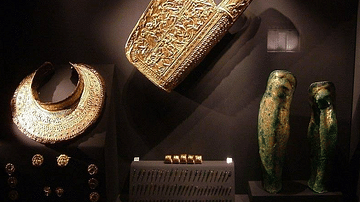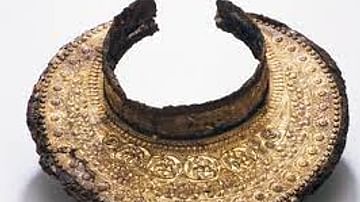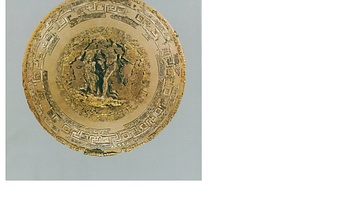Search
Search Results

Article
The Royal Macedonian Tombs at Vergina
Excavations at Vergina in northern Greece in the late 1970s CE unearthed a cluster of tombs thought to be the burial site of Philip II (r. 359-336 BCE), the father of Alexander the Great (r. 336-323 BCE), with a wife interred in a vaulted...

Article
Warrior Women of the World of Ancient Macedon
The 8th November is celebrated as Archangels Day in Greece, but on that November day in 1977 CE something remarkable happened: an excavation team led by Professor Manolis Andronikos were roped down into the eerie gloom of an unlooted Macedonian-styled...

Image
Greek Larnax from the Royal Tomb in Vergina
The gold chest or "larnax" containing male bones from the main chamber of the royal tomb known as "Tomb II" in Vergina. The chest is decorated with the royal “Vergina Sun” or “Star” symbol, which has been associated with the Argead dynasty...

Image
Iron Peritrachelion (gorget) from Macedonian Tomb II of Vergina
Iron peritrachelion (gorget) with golden-silver decorative plate found in Macedonian Tomb II of Vergina, Imathia, Central Macedonia, Greece. The tomb is dated to between the end of the 4th century BCE and the beginning of the 3rd century...

Image
Professor Theodore Antikas with Laura-Wynn Antikas Holding the Shorter Greave from the Royal Tomb of Vergina
Professor Theodore Antikas with Laura-Wynn Antikas holding the shorter greave from the Royal Tomb of Vergina in front of the display cabinet in the Archaeological Museum of Vergina. Courtesy of the Antikas team archive.

Image
Hades Abducting Persephone, Vergina
A fresco depicting the Abduction of Persephone by Hades, lord of the Underworld, on the wall of Tomb I at Vergina, Macedon, Greece.

Image
Excavation of the Vaulted Tomb at Aegae, Vergina
The roof and facade of the vaulted tomb in Aegae (Vergina) emerging from the soil in 1977 CE. From Unearthing the Family of Alexander the Great. Grant (2019) p51. Used with permission from Pen & Sword Books.

Image
Scythian Quiver & Armour of a Woman, Vergina
The gold quiver, shin-guards and neck armour of the female in the unlooted 4th Century BCE tomb at Vergina, Greece, discovered in November 1977 CE.

Image
Entrance of the Archaeological Museum of Vergina
The entrance to the subterranean Archaeological Museum of Vergina., in Macedon, Greece,

Image
Wreath & Ceremonial Shield from Tomb II, Vergina
The gold wreath and ceremonial shield from the main chamber of Tomb II, in Aigai (Vergina). From Unearthing the Family of Alexander the Great. Grant (2019). Used with permission from Pen & Sword Books.